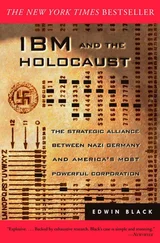Edwin Black - War Against the Weak
Здесь есть возможность читать онлайн «Edwin Black - War Against the Weak» весь текст электронной книги совершенно бесплатно (целиком полную версию без сокращений). В некоторых случаях можно слушать аудио, скачать через торрент в формате fb2 и присутствует краткое содержание. Город: Washington, DC, Год выпуска: 2012, ISBN: 2012, Издательство: Dialog Press, Жанр: История, на английском языке. Описание произведения, (предисловие) а так же отзывы посетителей доступны на портале библиотеки ЛибКат.
- Название:War Against the Weak
- Автор:
- Издательство:Dialog Press
- Жанр:
- Год:2012
- Город:Washington, DC
- ISBN:1-56858-258-7
- Рейтинг книги:3 / 5. Голосов: 2
-
Избранное:Добавить в избранное
- Отзывы:
-
Ваша оценка:
- 60
- 1
- 2
- 3
- 4
- 5
War Against the Weak: краткое содержание, описание и аннотация
Предлагаем к чтению аннотацию, описание, краткое содержание или предисловие (зависит от того, что написал сам автор книги «War Against the Weak»). Если вы не нашли необходимую информацию о книге — напишите в комментариях, мы постараемся отыскать её.
War Against the Weak — читать онлайн бесплатно полную книгу (весь текст) целиком
Ниже представлен текст книги, разбитый по страницам. Система сохранения места последней прочитанной страницы, позволяет с удобством читать онлайн бесплатно книгу «War Against the Weak», без необходимости каждый раз заново искать на чём Вы остановились. Поставьте закладку, и сможете в любой момент перейти на страницу, на которой закончили чтение.
Интервал:
Закладка:
The plan’s most startling feature involved external and internal deportation. To save expense, large numbers of candidates would not be sterilized but simply thrown out of the state. Immigrants would be deported to their native countries. “Unfit” American citizens would be declared “aliens” in their own country. They would then be expelled to their family’s original ancestral locale. For example, an American adjudged an “unfit alien” might be traced generations back to Indiana, Virginia, Kentucky, Massachusetts, or North Carolina. That person and his entire family, under the guidelines, would be rounded up and deposited into the so-called “originating state.” The legal and biological justification for this action was set forth in report volume 1, on page 53, in section 12, entitled “The Intertown and Interstate Deportation of Socially Inadequate and Handicapped Person.”
In other words, the joint Carnegie Institution-Connecticut plan was to create domestic refugees or displaced persons in a fashion identical to that employed by the Nazis at that very moment in refugee-torn Europe. Just as in Germany, based upon the same ideals and principles, the unwanted would be stripped of their citizenship, and then declared “aliens” to be deported—somewhere. Legal precedents, according to Laughlin in the report, were based on Sec. 1690 of the 1930 Connecticut Revised Statutes, a section entitled “Deportation,” which called for paupers and other undesirables to be exiled from the state to their previous or ancestral locale.
Ultimately, so many people would be dumped into ancestral towns and states, creating so vast a social displacement problem, that concentration camps would be needed to handle the uprooted population. Property was to be seized to pay for the economic drain on the state. Once again, the process was a mirror image of the genocidal Nazi program implemented against Jews.
Page 56 of the report states, “If exile, or ‘encouraged emigration,’ or ‘dumping’ were no longer possible” due to the masses to be internally deported, American states that “now permit the production of certain types of human defectives and inadequates would be compelled to consider more seriously a practical means for the reduction of their supply.”
The next page itemized five special remedies for “population control.” These included segregation in camps, forced exile, sterilization, and marriage prohibition. Item 5 was entitled “Euthanasia.” Laughlin explained, “In some communities ‘mercy death’ has been advocated in certain extreme cases… but the modern American state has not yet worked out ‘due process of law’ nor has it yet decided on who should sit in judgment.” He went on to suggest, “The legality and protection finally found in the eugenical sterilization laws after twenty years of experimental legislation give some hope that a similarly sound basis for euthanasia might be worked out… for states or communities which desire it.” Inevitably, the concentration camps for deportees to be set up in North Carolina, Kentucky, Indiana, and other states of “defective” human origination were to be converted into eugenicide mills—that is, death camps. Whether these death camps were to be operated in Connecticut or the state receiving the expelled aliens was a detail to be worked out by “interstate treaties.” These “treaties” would be engineered by like-minded eugenic advocates in the legislatures of Connecticut and recipient states, such as North Carolina and Virginia, using the robust interstate cooperation model perfected during the quest to achieve mass sterilization. To that end, on page 66 in a section headed “Needed Researches,” project 8 “Euthanasia—Mercy Death,” the task was set forth: “compile and analyze all past and existing statues of all nations which bear upon the subject.”
During these same days, the Third Reich was considering a program, which was ultimately launched the next year, 1939, under the codename “T-4.” Under T-4, Nazi doctors gassed tens of thousands of so-called “defectives.” One of the nations Laughlin was always willing to proffer as a shining example in his deliberations and suggestions was Nazi Germany.
As Laughlin’s report to Connecticut’s governor trumpeted, “The elimination or reduction of members of degenerate human stocks” was the social imperative. Since the first years of the twentieth century, euthanasia had always been the official holy grail of the American eugenics movement. Gas was the preferred method. In 1906, the first eugenicide legislation was proposed in the Ohio legislature. Iowa also tried to pass such legistlation. In 1912, the Carnegie Institution, at the First International Eugenics Congress, held in London, established euthanasia as official doctrine within the movement. Creating the legal underpinnings for systematic extermination was a constant struggle for advocates.
Until euthanasia could be legalized, sterilization, segregation, and/or deportation would have to suffice. Connecticut officials wasted no time.
One Connecticut town, Rocky Hill, was selected as a model for biological surveillance. Nearly all of the town’s 2,190 citizens were registered and almost half fingerprinted. A proposed racial registration card for IBM technology was part of the state’s study. IBM had established a record as expert in deadly population control, designing and executing Hitler’s efforts to identify Jews, find their assets, and deport them. Ironically, IBM’s Nazi technology was actually first tested by the company in a pilot program in Jamaica in 1928, five years before the Hitler regime. The Carnegie Institution’s 1928 Jamaica Race-Crossing Project introduced the race classification card that evolved into the SS card that IBM used in Germany. The Jamaica Race-Crossing Project was the first step in a plan to wipe out all black people on earth. Indeed, the American eugenics movement was less successful precisely because it lacked the punch-card technology that IBM so carefully developed for the Nazi eugenic and extermination campaigns.
Connecticut’s project was never implemented on the scope desired, not much beyond the first surveillance steps taken in Rocky Hill. Governor Cross lost his 1938 re-election bid. With Cross out of office, Connecticut cast aside Laughlin’s project. Just a few copies of the full secret report were ever circulated. State officials hoped no one would ever discover their plans.
North Carolina Confronts Its Genocide
Of the more than thirty American states that violated one of the most basic rights of their citizens—the right to procreate—few were as pernicious as North Carolina. Yet the nature of North Carolina’s history also illustrates the challenge of obtaining modern-day justice, even when the most energetic efforts are undertaken. The state has been on a decades-long collision course with its own campaign to eliminate the existence of a significant portion of its population. Most importantly, the crimes committed by the state in conjunction with the leading academic, scientific, judicial, legal, and medical authorities were never about just improving perceived conditions in North Carolina. Rather, it was always about the state doing its fair share to achieve international race purification. This meant close coordination, cooperation, and synchrony with the most virulent eugenic leaders around the world, from California to Connecticut to Nazi Germany. What North Carolina did was never a local transgression; it was part of a global aggression in pursuit of a master race.
North Carolina’s first step from mere eugenic attitudes about race supremacy to active legislation began with a 1919 law enabling coercive sterilization. But that first law was so vague, not even mentioning the term sterilization , that it was considered unusable. While there may have been some ad hoc and maverick sterilizations done at the time, state files show no officially-sanctioned sterilizations during that period.
Читать дальшеИнтервал:
Закладка:
Похожие книги на «War Against the Weak»
Представляем Вашему вниманию похожие книги на «War Against the Weak» списком для выбора. Мы отобрали схожую по названию и смыслу литературу в надежде предоставить читателям больше вариантов отыскать новые, интересные, ещё непрочитанные произведения.
Обсуждение, отзывы о книге «War Against the Weak» и просто собственные мнения читателей. Оставьте ваши комментарии, напишите, что Вы думаете о произведении, его смысле или главных героях. Укажите что конкретно понравилось, а что нет, и почему Вы так считаете.












